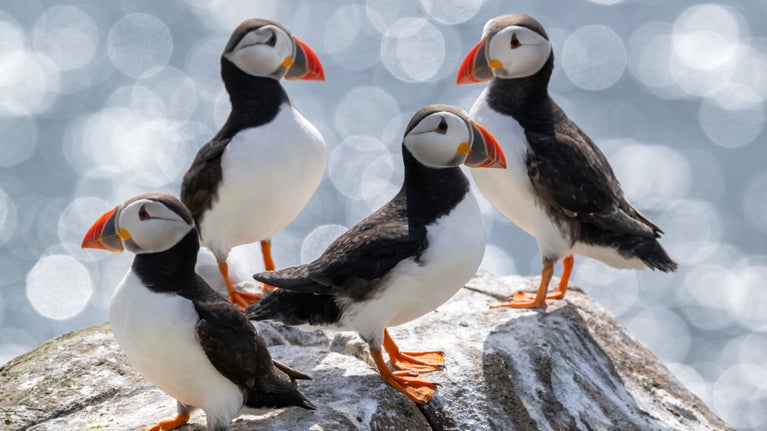Mixed fortunes for Farne Islands’ seabirds in 2025 breeding season
- Published:
- 26 November 2025

Annual bird counts on the Farne Islands have revealed a mixed picture for the internationally important seabird colonies two years after several species were severely impacted by an outbreak of Avian Influenza.
This year’s count on the Islands, an internationally significant sanctuary for the 200,000 seabirds that return each summer to breed, was vitally important given the islands’ three seasons of closure between 2020 and 2024, firstly due to Covid-19, followed immediately by bird flu, which saw 6,000 dead birds recovered from the islands, with thousands more thought to be lost at sea.
The puffin, for which the islands are best known, saw numbers of breeding pairs drop 23% on 2024’s figures – 50,103 to 38,500 breeding pairs. Yet, despite this decrease, experts are cautioning against interpreting it as a sudden population decline, noting the need for long-term monitoring.
Ben McCarthy, Head of Nature Conservation at the National Trust said: “Counting puffins is a notoriously complex task. There is no single perfect method, and annual variations in survey conditions, puffin behaviour, and environmental factors all influence the count.
“While the decline in numbers is concerning, it’s important to view this year’s results within the broader context of global puffin trends. The shift we made to annual monitoring in 2019 reflects the Trust’s commitment to understanding and protecting puffins over the long term.
“The puffins, although impacted by the bird flu outbreak in 2022/23, were not as impacted as other species thanks in part to their naturally self-isolating behaviour of nesting in burrows and their regular burrow cleaning.
“To better ensure the accuracy of our data we will now reassess density areas every five years to better reflect the dynamic nature of the islands’ landscape. Soil erosion, driven by the expanding grey seal colony and extreme weather events such as Storm Arwen a few years ago, is reshaping puffin nesting habitats - making structured long-term monitoring more critical than ever.”
In addition to aiming to counter the impacts of more extreme weather events, the Trust implements measures to deter seals from disturbing puffin nesting areas during their breeding season. These include the use of scarecrows, sound-based deterrents, and partial barriers positioned near high-density nesting sites. The aim is to encourage seals to remain within their usual pupping areas, minimising disturbance to puffin burrows while maintaining a respectful balance between both species.
Sophia Jackson, Farne Islands Area Ranger, added: “We know puffins are facing challenges globally, from climate change to shifting food sources. What we’re seeing on the Farnes is part of a much bigger picture. This year’s census doesn’t necessarily mean puffins are disappearing overnight - but it does reinforce the need for consistent, long-term data. That’s why we’ve moved to annual surveys. It helps us respond more quickly to changes and protect these incredible birds more effectively.”
Surveys of other seabird populations on the Farne Islands have revealed several encouraging trends, with some species showing encouraging increases on 2024 figures, when a partial count was undertaken on some species due to bad weather preventing rangers from reaching all islands.
Among the most encouraging results is the Northern Fulmar, with numbers appearing to more than double — rising from 106 to 235 nesting pairs. Common Eider numbers also saw a strong upward trend, increasing by over 50%. Other species appearing to show positive gains include the Greater Black-backed Gull (up 100%), Herring Gull (up 58%) and European Shag (up 57%). Razorbills rose by 22.5%, while Guillemots experienced a modest increase of 2%.
Arctic Terns, one of the Farnes’ most iconic species, also saw a healthy rise, increasing by over 26% on 2024 figures, from 410 to 519 nesting pairs, a welcome boost for a species that faces increasing pressure from climate change and food availability.
Unfortunately, other species did struggle, including other rare tern populations with Common Tern numbers appearing to fall by half (10 to 5 pairs). Rangers have also expressed concern about the Sandwich terns following an early nest abandonment which prevented an accurate count; however, some birds were spotted on nearby Coquet Island later in the season.
A safe haven thanks to its location 1.5 miles off the coast of Northumberland, the 28 islands with varying visibility depending on the tide, provide the ideal habitats for 23 species of breeding birds, as well as being an important stop-off point for a host of migratory birds from Long-eared Owls to Bluethroats and Ring Ouzels.
During the winter it is also home to a significant colony of grey seals who return each year to pup.
For more information on the Farne Islands and the species that live and migrate there, visit www.nationaltrust.org.uk/visit/north-east/farne-islands